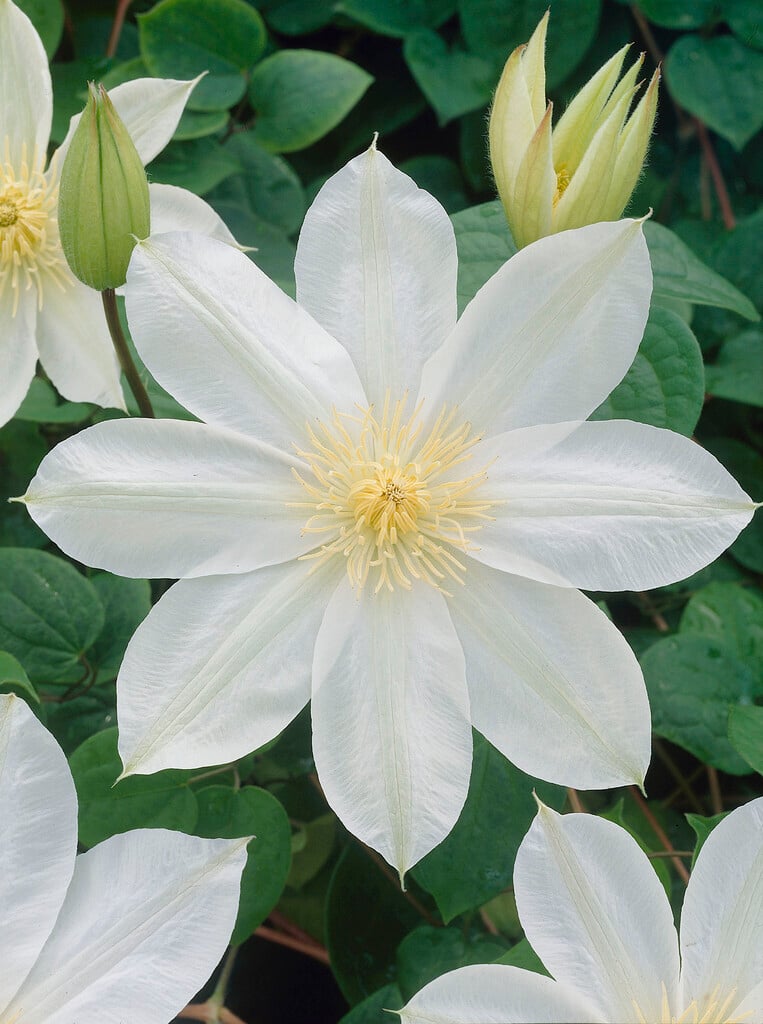Clematis patens 'Manshuu Ki' (EL)
clematis 'Manshuu Ki'
Compact, deciduous climber about 3m in height, with pale green leaves and bearing large, scented, single flowers to 18cm across, creamy-yellow or pale yellow-green, deeper in colour along the central ridged band on each petal, with creamy-yellow stamens, flowering late spring to early summer and late summer. Long-lasting shiny, spherical seedheads follow
Size
Ultimate height
2.5–4 metresTime to ultimate height
2–5 yearsUltimate spread
1.5–2.5 metresGrowing conditions
Moisture
Moist but well–drained, Well–drainedpH
Acid, Alkaline, NeutralColour & scent
| Stem | Flower | Foliage | Fruit | |
| Spring | Yellow | Green | ||
|---|---|---|---|---|
| Summer | Yellow | Green | ||
| Autumn | Green | Cream Grey Silver | ||
| Winter |
Position
- Partial shade
Aspect
West–facing or East–facing or North–facing
Exposure
Sheltered Hardiness
H5Botanical details
- Family
- Ranunculaceae
- Native to GB / Ireland
- No
- Foliage
- Deciduous
- Habit
- Climbing
- Potentially harmful
- Skin irritant. Wear gloves and other protective equipment when handling. Pets (rabbits): Harmful if eaten. For further information and contact numbers regarding pets, see the HTA guide to potentially harmful plants
- Genus
Clematis can be deciduous or evergreen shrubs or herbaceous perennials, mostly climbing by twining leaf-stalks, and often with showy flowers. Some have attractive fluffy seedheads in autumn
- Name status
Accepted
- Horticultural Group
- Early Large-flowered clematis have large star-shaped flowers in early summer, often with a second flowering in late summer
How to grow
Cultivation
Plant in moisture-retentive, well-drained soil, best in part shade, with the roots and base of the plant kept cool and shaded by other plants or a layer of pebbles at the base. Plant with the crown 5-8cm deep to encourage new shoots to grow from below ground level. See clematis cultivation
Propagation
Propagate by softwood cuttings in spring, semi-ripe cuttings in early summer or layering
Suggested planting locations and garden types
- City and courtyard gardens
- Cottage and informal garden
- Climber and wall shrubs
- Wall side borders
Pruning
Pests
May be susceptible to aphids, snails and caterpillars; petals may be eaten by earwigs
Diseases
May be susceptible to honey fungus (rarely), clematis wilt and clematis slime flux
Get involved
The RHS is the UK’s gardening charity, helping people and plants to grow - nurturing a healthier, happier world, one person and one plant at a time.
